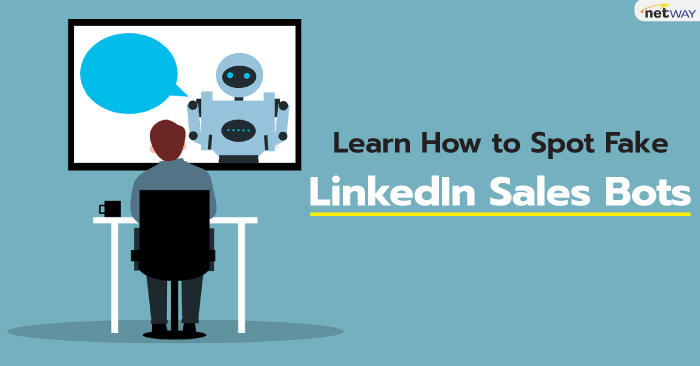-
Welcome to My Website
This is a text box. Write your own content here. This is an excellent place for you to add a paragraph.
Learn How to Spot Fake LinkedIn Sales Bots

“วิธีสังเกตโปรไฟล์ LinkedIn ของปลอม”
FBI ระบุว่าอาชญากรรมออนไลน์ผ่าน LinkedIn กำลังมีมากขึ้นอย่างน่ากลัว เพราะยิ่ง LinkedIn ได้รับความนิยมจากคนทำงานและ ธุรกิจมากขึ้นเท่าไร ก็ยิ่งมีภัยคุกคามมากขึ้นเรื่อยๆ
แล้วเราจะรู้ได้อยากไรว่าโปร์ไฟล์ที่ติดต่อเป็นของจริง หรือของปลอม❓แนะนำให้สังเกตุจุดต่างๆ ตามนี้
❗️โปรไฟล์ที่ไม่สมบูรณ์และรูปถ่ายทั่วไป คือ ของปลอม
❗️ข้อความที่ไม่มีความเป็นส่วนตัว คือ ของปลอม
❗️เนื้อหาส่งเสริมการขายที่มากเกินไปและกล่าวอ้างที่ไม่สมจริง คือ ของปลอม
❗️ไวยากรณ์และการสะกดคำไม่สอดคล้องกันคำขอเชื่อมต่อที่ผิดปกติและโปรไฟล์ที่ไม่คุ้นเคย คือ ของปลอม
หากคุณสนใจวิธีป้องกันภัยออนไลน์สำหรับคุณหรือธุรกิจ สามารถติดต่อเราได้ตามช่องทางเหล่านี้
Contact Netway Communication (24x7)
📲: 02 055 1095
👨💻Web chat: https://netway.co.th/
💙Facebook Messenger: @netway.official https://www.facebook.com/netway.official
💚Add Line ID: @netway https://bit.ly/line-netway
#LinkedInSecurity #FakeSalesBots #Cybersecurity#LinkedInTips #SpotFakeBots #DataSecurity
Learn How to Spot Fake LinkedIn Sales Bots

LinkedIn has become an invaluable platform for professionals. People use it to connect,
network, and explore business opportunities. But with its growing popularity have come
some red flags. There has been an increase in the presence of fake LinkedIn sales bots.
These bots impersonate real users and attempt to scam unsuspecting individuals. This is
one of the many scams on LinkedIn. According to the FBI, fraud on LinkedIn poses a
“significant threat” to platform users.
In this blog post, we will delve into the world of fake LinkedIn sales bots. We’ll explore their tactics and provide you with valuable tips. You’ll learn how to spot and protect yourself from these scams. By staying informed and vigilant, you can foster a safer LinkedIn experience.
Identifying Fake LinkedIn Sales Connections
Social media scams often play on emotions. Who doesn’t want to be thought of as special or interesting? Scammers will reach out to connect. That connection request alone can make someone feel wanted. People often accept before researching the person’s profile.
Put a business proposition on top of that, and it’s easy to fool people. People that are
looking for a job or business opportunity may have their guard down. There is also an
inherent trust people give other business professionals. Many often trust LinkedIn
connections more than Facebook requests.
How can you tell the real requests from the fake ones? Here are some tips on spotting the scammers and bots.
Incomplete Profiles and Generic Photos
Fake LinkedIn sales bots often have incomplete profiles. They’ll have very limited or
generic information. They may lack a comprehensive work history or educational
background. Additionally, these bots tend to use generic profile pictures. Such as stock
photos or images of models.
If a profile looks too perfect or lacks specific details, it could be a red flag. Genuine LinkedIn users usually provide comprehensive information. They do this to establish credibility and foster trust among their connections.
Impersonal and Generic Messages
One of the key characteristics of fake sales bots is their messaging approach. It's often
impersonal and generic. These bots often send mass messages that lack personalization.
They may be no specific references to your profile or industry. They often use generic
templates or scripts to engage with potential targets.
Legitimate LinkedIn users, typically tailor their messages to specific individuals. They might mention shared connections, recent posts, or industry-specific topics. Exercise caution If you receive a message that feels overly generic. Or one that lacks personalization. Be sure to scrutinize the sender's profile before proceeding further.
Excessive Promotional Content and Unrealistic Claims
Fake LinkedIn sales bots are notorious for bombarding users. You’ll often get DMs with
excessive promotional content and making unrealistic claims. These bots often promote
products or services aggressively. Usually without offering much information or value.
They may promise overnight success, incredible profits, or instant solutions to complex
problems. Genuine professionals on LinkedIn focus on building relationships. They try to
provide valuable insights and engage in meaningful discussions. Instead of resorting to
constant self-promotion.
Be wary of connections that focus solely on selling. And that don’t offer any meaningful content or engagement.
Inconsistent or Poor Grammar and Spelling
When communicating on LinkedIn, pay attention to the grammar and spelling of messages. You may dismiss an error from an international-sounding connection, but it could be a bot.
Fake LinkedIn sales bots often display inconsistent or poor grammar and spelling mistakes.
These errors can serve as a clear sign that the sender is not genuine. Legitimate LinkedIn
users typically take pride in their communication skills. They try to maintain a high
standard of professionalism.
If you encounter messages with several grammatical errors or spelling mistakes, exercise caution. Investigate further before engaging with the sender.
Unusual Connection Requests and Unfamiliar Profiles
Fake LinkedIn sales bots often send connection requests to individuals indiscriminately. They may target users with little regard for relevance or shared professional interests.
Be cautious when accepting connection requests from unfamiliar profiles. Especially if the
connection seems unrelated to your industry or expertise.
Take the time to review the requesting profile. Check their mutual connections, and assess the relevance of their content. Legitimate LinkedIn users are more likely to have a connection. They typically send connection requests to others with shared interests or professional networks. 11
Need Training in Online Security?
บทความในส่วนนี้
-
แนวทางการใช้ Microsoft 365 Copilot เพื่อเพิ่มประสิทธิภาพการทำงาน และการสร้าง Prompt ในสายงานต่างๆ
Updated on 2025-12-03 04:57:55
-
ของขวัญปีใหม่จาก Netway ซื้อหรืออัปเกรด Microsoft 365 Business Premium วันนี้ รับคูปองเติมน้ำมันฟรี
Updated on 2025-12-01 03:55:53
-
มีอะไรใหม่ใน Microsoft 365 Copilot ช่วงท้ายปี 2025
Updated on 2025-11-27 04:07:37
-
November 2025 - Netway Combo ข่าวสารรายเดือน พ.ย. 2568
Updated on 2025-11-06 09:20:17
-
ข่าวดี! Microsoft 365 Enterprise Plan สามารถซื้อพร้อม Microsoft Teams ได้อีกครั้งแล้ว
Updated on 2025-11-05 04:07:35

-
Domain
-
Hosting
-
Cloud & Managed
-
SSL
-
Email
- เรียนรู้เพิ่มเติม
- Microsoft 365 รุ่นต่างๆ
- Microsoft 365 สำหรับธุรกิจ
- Microsoft 365 สำหรับใช้งานที่บ้าน
- ทดลองฟรี
- G Suite
- เทคนิคลดต้นทุนอีเมล Microsoft 365 มากกว่า 28%
- เทคนิคลดต้นทุนอีเมล G Suite มากกว่า 19%
- Zimbra-Based Email
- Traditional Email by cPanel
- Physical to Cloud Migration
- Exchange Server to Microsoft 365 Migration
- G Suite to Microsoft 365 Migration
- Microsoft 365 to G Suite Migration
- Cloud to Cloud Migration
-
Microsoft
-
Google
-
Marketing
-
Others
-
Blog
-
Microsoft Teams
-
microsoft-365-business-premium
-
test-slide
-
Order
-
Promo